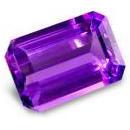|
ClassicGems.net |
|
|
 |
|
Amethyst (variety of Quartz) |
|
|
Discovered in prehistory; IMA status: Not Valid (a variety of Quartz) |
|||
|
|
|
Chemistry |
|
|
|
|
|
SiO2 |
|
|
|
Silicon Dioxide |
|
Molecular Weight: |
60.08 gm |
|
Composition: |
Silicon |
46.74 % |
Si |
100.00 % |
SiO2 |
|
|
Oxygen |
53.26 % |
O |
|
|
|
|
|
100.00 % |
|
100.00 % |
= TOTAL OXIDE |
|
|
|
||||
|
Classification |
|
|
|
|
|
Oxides |
|
|
4/D.01-10 |
|
|
|
4 : OXIDES (Hydroxides, V[5,6] vanadates, arsenites, antimonites,
bismuthites, sulfites, selenites, tellurites, iodates) |
|
Related to: |
Quartz is a polymorph of Coesite, Cristobalite, Stishovite and Tridymite. |
|
Members of Group: |
n/a |
|
Varieties: |
Hair Amethyst |
|
Synonyms: |
Amethystine Agate, Amethystine quartz, Bishops Stone, Lavendine, Spirit Quartz |
|
|
|
|
Crystal Data |
|
|
|
|
|
As
enantimorphic prismatic crystals; may be morphologically
complex, with over 500 forms noted, to 6 meters and
36 tons; |
|
|
Very common, penetration twins on the Dauphiné law, about [0001], and the Brazil law, with [1120] as contact plane; contact twins on the Japan law, with [1122] as contact plane, may be repeated; and several other laws. |
|
|
|
|
|
Physical Properties |
|
|
|
|
|
None or [0110] Indistinct |
|
|
Conchoidal |
|
|
Brittle |
|
|
7.0 |
|
|
2.60 - 2.65 (g/cm3) |
|
|
May be Triboluminescent; varies widely due to traces of impurities. |
|
|
Not Radioactive |
|
|
Other: |
Piezoelectric and Pyroelectric and may be Triboluminescent |
|
|
|
|
Optical Properties |
|
|
|
|
|
Pale Lilac, Violet, Purple |
|
|
Transparent |
|
|
Vitreous (Glassy) |
|
|
1.544 - 1.553 Uniaxial ( + ) |
|
|
0.0090 |
|
|
0.013 |
|
|
Weak |
|
|
|
|
|
Occurances |
|
|
|
|
|
Geological Setting: |
In hydrothermal veins, epithermal to alpine; characteristic of granites and granite pegmatites; in sandstones and quartzites, less abundant in other rock types; in hydrothermal metal deposits. Common in carbonate rocks; a residual mineral in soils and sediments. |
|
Common Associations: |
Calcite, Chlorite, Epidote, Feldspars, Fluorite, Micas, Zeolites, many other species |
|
Common Impurities: |
Fe |
|
Type Locality: |
None (prehistoric) |
|
Year Discovered: |
Prehistoric |
|
View mineral photos: |
|
|
|
|
|
More Information |
|
|
|
|
|
|
Mindat.org
(Amethyst) |
|
|
|
|
Amethyst is the purple variety of Quartz and has been associated with royalty throughout history. Quartz is one of the most common minerals on Earth. Other varieties of Quartz include Ametrine and Citrine. Amethyst comes in a variety of colors, from pale violet to deep purple with red flashes. The color is due to trace amounts of iron impurities added to the basic silicon dioxide formula. Amethyst was named from the Greek word amethystos, meaning not drunken because the Greeks believed that drinking from an Amethyst cup would prevent intoxication. Amethyst is available from sources worldwide with notable occurances in Brazil; Mexico; Namibia; Nigeria; Uraguay; Arizona and North Carolina, USA; USSR; and Zambia. |
|
|
Amethyst gems for sale: We have not photographed the Amethyst gems yet. Please check back soon. |